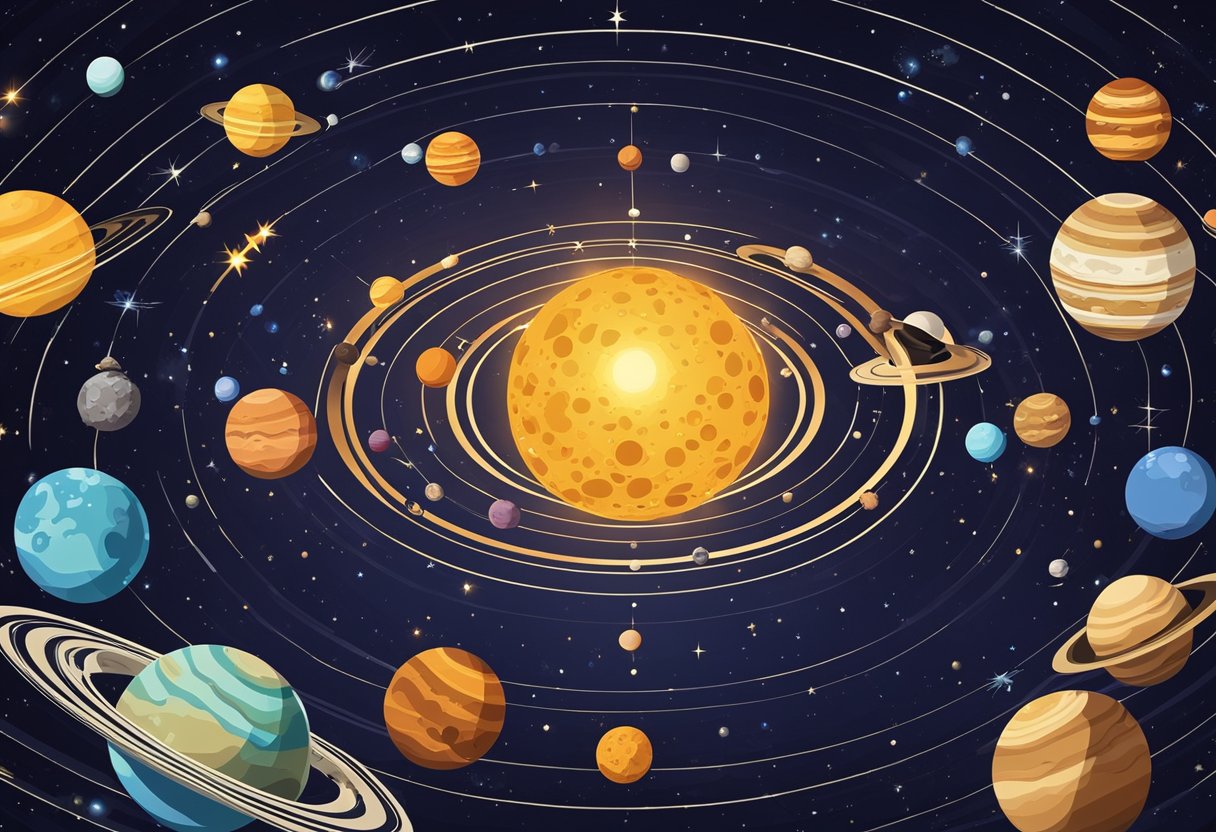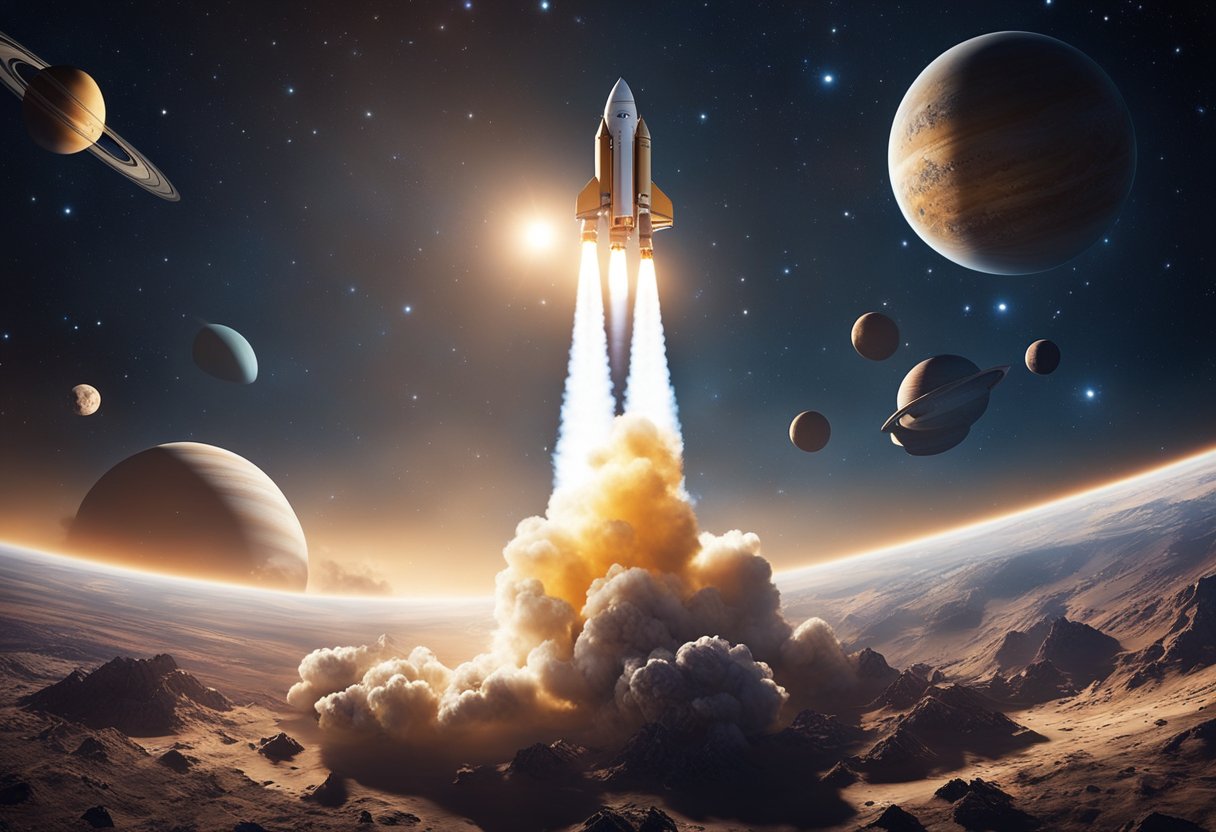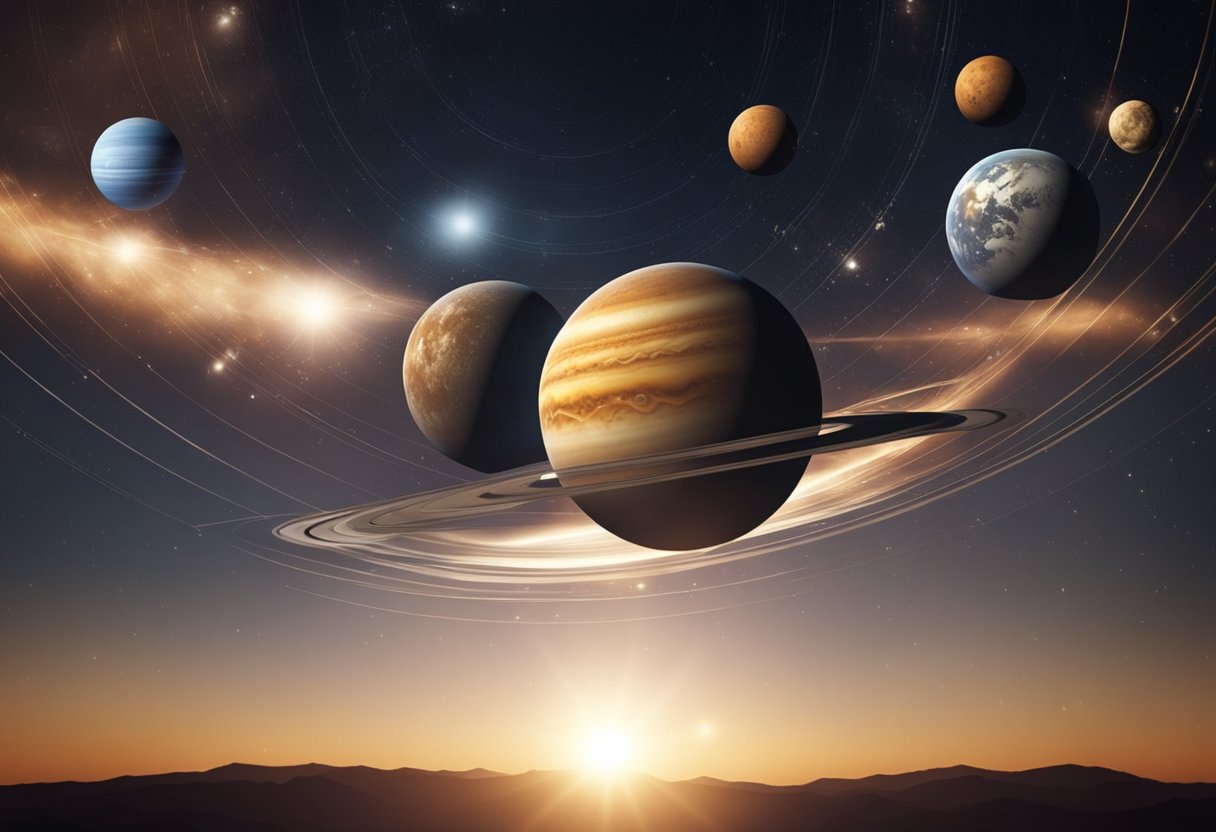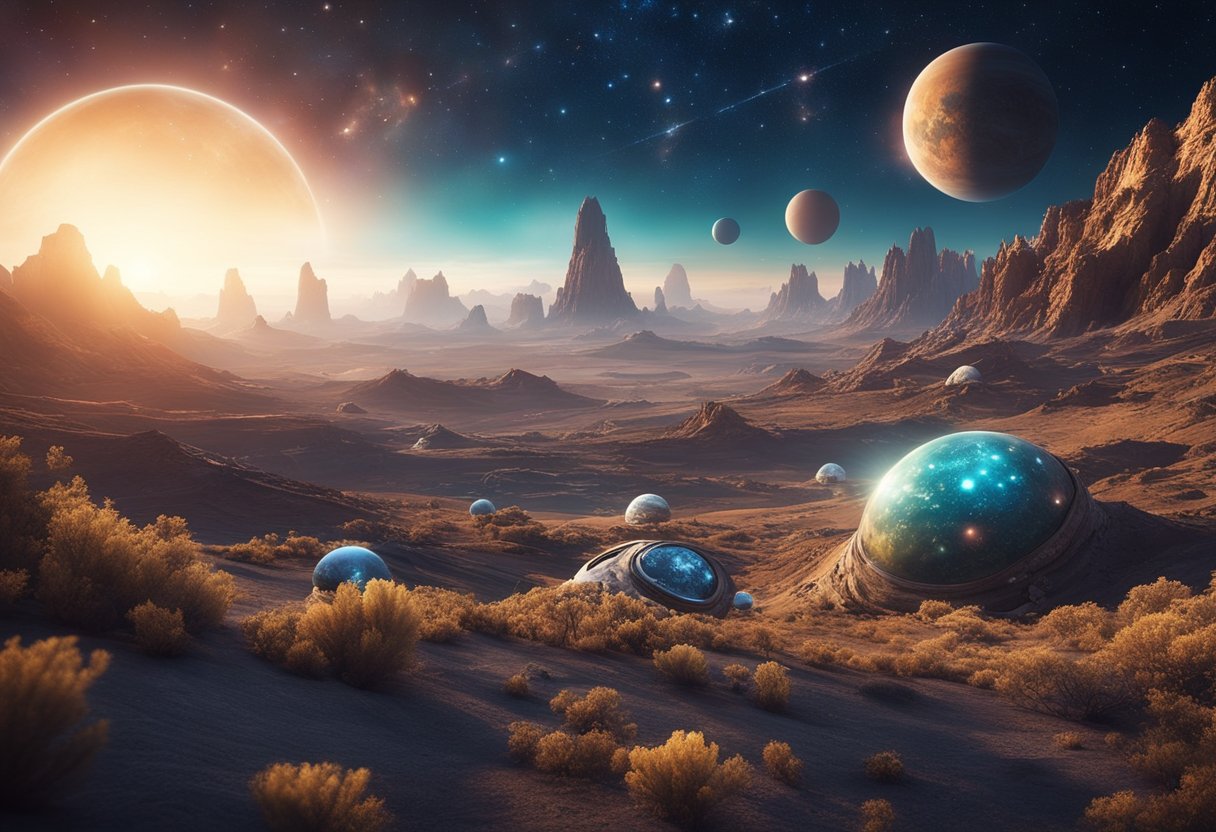
Kids’ Guide to the Solar System – The solar system is our cosmic neighbourhood, a collection of planets, moons, and other celestial bodies orbiting our star, the Sun. Journeying through space means exploring a vast expanse filled with awe-inspiring phenomena, from the rocky inner planets to the icy realms of the outer system. As we look to the sky, it’s important to understand the family of planets that share the Sun with us, each unique in its composition and appearance.

Embarking on a spatial adventure unveils the intricate ballet of gravity and motion that keeps the planets in their paths around the Sun. Our understanding of the universe has expanded greatly with the exploration of the asteroid belt, the mysterious dwarf planets, and the gas and ice giants that dominate the outer regions of the solar system. The more we learn about our solar system, the more we appreciate its complexity and the profound questions it poses about our place in the universe.
In our journey through the cosmos, the Sun is our closest stellar neighbour and the most influential celestial body within our solar system. It’s a massive sphere of hot plasma that provides the essential light and heat necessary for life on Earth.
The Sun is a gargantuan ball primarily composed of hydrogen and helium. It accounts for about 99.86% of our solar system’s total mass. The core of the Sun is where energy production occurs, through a process called nuclear fusion, converting hydrogen into helium at an enormous scale. This thermonuclear process releases energy that travels outward to the solar surface before radiating into space.
The Sun also emits a continuous flow of charged particles known as the solar wind, which travels through the solar system at speeds of about 400 to 700 kilometres per second. When these particles encounter Earth’s magnetic field, they can cause phenomena such as the auroras – the Northern and Southern Lights. The solar wind can also influence the orbits of comets and has implications for space weather, which can affect satellite operations and astronaut safety during space travel.
As we embrace the future of space exploration and potential space tourism with ventures like SpaceVoyageVentures.com, understanding the Sun’s role in our solar system remains crucial for our ventures into the cosmos.
We find that in our solar system, four planets stand out as being rocky, known as the terrestrial planets: Mercury, Venus, Earth, and Mars. Each has unique characteristics that distinguish it from the others in our celestial neighbourhood.
Mercury, the planet closest to the Sun, experiences the most extreme temperature fluctuations in our solar system. Daytime temperatures can soar up to 430 degrees Celsius, which is hot enough to melt lead, while night-time temperatures drop to a frigid -180 degrees Celsius. Despite being barren and devoid of any atmosphere to speak of, Mercury’s day and night provide a stark contrast that emphasises the harshness of space.
Often considered Earth’s twin due to its similar size and proximity, Venus is unique with its dense, toxic atmosphere mostly composed of carbon dioxide with clouds of sulfuric acid. The surface temperature here remains a steady 470 degrees Celsius, which is even hotter than Mercury, due to an intense greenhouse effect.
Earth, our home planet, stands out as the only world known to support life, thanks to our life-sustaining atmosphere and the presence of liquid water. Our atmosphere protects us from harmful space radiation and has just the right composition to support various life forms. We’re also the only planet in our solar system with substantial quantities of liquid water, covering about 71% of our surface, a critical ingredient for life as we know it.
Mars, known as the Red Planet due to its iron oxide-rich soil, offers the most Earth-like conditions after our own planet. With the discovery of water on Mars in the form of ice and fleeting liquid water, Mars becomes a prime candidate for extraterrestrial life and future colonisation. Although its thin atmosphere cannot support liquid water on the surface for long periods, our ongoing explorations may uncover more about Mars’s potential to host life and perhaps one day support our own.
We can be excited about the future as we continue to explore these rocky worlds, not just for scientific knowledge, but also for the potential of space tourism, as detailed in early plans by pioneering companies like SpaceVoyageVentures.com.
In our guide, we’ll explore a significant part of our Solar System, the Asteroid Belt, home to countless asteroids and dwarf planets like Ceres.
Ceres stands out as the colossal member of the asteroid belt and bears the title of a dwarf planet. Discovered in 1801, it is the largest object in the asteroid belt and accounts for a considerable portion of the belt’s total mass. Unlike the smaller, rockier asteroids that populate the same region, Ceres is spherical, which is a characteristic of a dwarf planet. Our understanding of Ceres has expanded with recent space missions providing detailed observations of its composition and surface features.
This dwarf planet is particularly intriguing as it presents signs of water-ice on its surface. The presence of water-ice suggests that Ceres may have a subsurface ocean or, at the very least, had significant water activity in its past. Study of Ceres not only gives us insight into the properties of dwarf planets but also helps us understand the early Solar System’s conditions.
Fast Facts about the Asteroid Belt:
The Asteroid Belt is a disc-shaped region teeming with a variety of asteroids, ranging from tiny rocks to dwarf planets nearly 950 kilometers across. It represents remnants from the Solar System’s formation era, with the pieces never coalescing into a planet due to Jupiter’s immense gravitational pull.
We see the potential for future exploration of the Asteroid Belt, not only for scientific research but for space tourism opportunities that could be profiled on platforms like SpaceVoyageVentures.com. While the concept may seem like science fiction now, the advancements in space technology could make tours of these cosmic structures a reality.
Before venturing into the vastness of our Solar System’s outer regions, it’s crucial to understand that two distinct types of gargantuan planets lie beyond the asteroid belt. The gas giants, epitomised by Jupiter and Saturn with their massive atmospheres, and the ice giants, Uranus and Neptune, with their icy cores and unique methane blue appearance, reign supreme in these outer reaches.
Jupiter, the largest planet in our Solar System, boasts a mass that is two and a half times that of all the other planets combined. This colossal planet is renowned for its Great Red Spot, a gigantic storm larger than Earth that has raged for centuries. Jupiter’s dominance is also evident in its grand entourage of moons, with a count exceeding 79, including the four large Galilean moons: Io, Europa, Ganymede, and Callisto.
Saturn is perhaps best known for its rings, a stunning array made mostly of ice particles with a sprinkle of rocky debris and dust. Among its 82 confirmed moons, Titan stands out as the second-largest moon in the Solar System and is larger than the planet Mercury. Titan’s dense atmosphere and liquid methane lakes make it a fascinating subject of study, while Enceladus intrigues us with its icy jets hinting at an underground ocean.
Further on, we encounter Uranus and Neptune, the ice giants. These planets are distinct from the gas giants, primarily due to their icy mantles that envelop their rock and metal cores. Uranus, with its unusual tilt, results in extreme seasonal variations, while Neptune, though smaller, is more massive and dense. These planets’ atmospheres contain methane, which gives them a striking blue colour, and they’re orbited by a collection of moons, such as Triton, one of Neptune’s most notable moons, known for its retrograde orbit and geysers.
Our Solar System is home to a fascinating variety of moons, ranging from the Earth’s only natural satellite to over 60 moons orbiting the massive gas giants. With remarkable features and terrain, these celestial bodies captivate astronomers and space enthusiasts alike.
The Moon, Earth’s natural satellite, presents a surface riddled with impact craters, plains, and mountain ranges. Extraordinary landforms such as the Tycho and Copernicus craters are visible even to amateur telescopes. Our lunar explorations have provided invaluable geological insights and continue to spur our curiosity for space.
The gas giants of our Solar System – Jupiter, Saturn, Uranus, and Neptune – collectively host an array of moons with distinct environments. Ganymede, a Jovian moon, holds the title as the largest moon in our system. In contrast, Saturn’s moons, including Titan, exhibit complex atmospheres and methane lakes.
Among Saturn’s collection, Titan stands out as the only moon enveloped by a thick atmosphere. It is a primary target for future exploration due to its potential subsurface ocean. Meanwhile, Jupiter’s Europa is encased in a shell of ice, beneath which lies an ocean that may harbour extraterrestrial life. Additionally, Io, another Jovian moon, showcases volcanic activity so intense it reshapes its surface regularly. Callisto sports one of the most heavily cratered landscapes, a testament to the ancient nature of its surface.
In our journey through the solar system, we encounter a variety of celestial bodies, each with their own fascinating characteristics. Among them are the comets, asteroids, and meteoroids, which are smaller than planets but play significant roles in our understanding of space.
Comets are icy bodies that release gas or dust. They originate from the outer reaches of the solar system and are known for their spectacular tails that become visible as they approach the Sun. The tails are the result of the Sun’s heat causing the comet’s ice to vaporise and dust to escape, creating a glowing coma. A famous example is Halley’s Comet, which is predicted to return to our view from Earth in 2061.
Asteroids are rocky objects that mainly reside in the asteroid belt between Mars and Jupiter. Generally smaller than planets, they range massively in size; some are as small as pebbles, while others, like Ceres, are hundreds of kilometres in diameter. Asteroids are remnants of the early solar system, giving us clues about its formation.
Meteoroids are small chunks of rock or debris in our solar system. They become meteors, often referred to as shooting stars, when they enter Earth’s atmosphere and burn up due to friction. If they survive their fiery journey and land on Earth’s surface, we call them meteorites.
Meteor showers are events in which a number of meteors are observed to radiate from one point in the night sky. These celestial shows are caused when Earth passes through the trail of dust and debris left behind by a comet. For instance, the Perseids are a spectacular meteor shower that occurs every year in August.
We invite you to continue to explore with us, and perhaps one day, via ventures like SpaceVoyageVentures.com, experience the awe of passing through a meteor shower or observing the tail of a comet firsthand as we venture further into the realm of space tourism.
As we journey to the outer reaches of our solar system, we encounter two colossal regions filled with cosmic objects: the Kuiper Belt, home to Pluto and countless icy bodies, and the mysterious Oort Cloud, a spherical shroud enveloping our planetary neighbourhood.
The Kuiper Belt is an expansive ring of icy objects beyond the orbit of Neptune, starting at about 30 astronomical units (AU) from the Sun—where 1 AU is the distance from the Earth to the Sun. Pluto, once known as the ninth planet, is now classified as a dwarf planet within this belt. Characterised by a ‘puffed-up disk’ shape, the belt contains a vast number of other dwarf planets and objects that are remnants from the solar system’s formation.
Far beyond the Kuiper Belt lies the Oort Cloud, an immense spherical cloud surrounding our solar system. Its existence is inferred by the long-period comets that swoop into our solar system from time to time. The Oort Cloud likely contains trillions of icy bodies in solar orbit, forming a thick bubble around our system. These icy fragments are thought to be as large as mountains and sometimes even larger, making the Oort Cloud an intriguing subject for future space exploration by ventures like SpaceVoyageVentures.com.

Our journey into the cosmos has been marked by extraordinary milestones, powered by remarkable spacecraft and persistent exploration through rovers, especially on the Martian surface. As we continue to push the boundaries of space exploration, these technological marvels remind us of our enduring quest to understand the universe and our place within it.
Spacecraft and probes are vital tools for our exploration of the solar system and beyond. Over the years, NASA has sent numerous probes to study planets, moons, and other celestial bodies. For instance, the New Horizons probe provided key insights into Pluto and the Kuiper Belt, expanding our understanding of these distant realms. Probes such as Voyager 1 and Voyager 2 have traversed the outer planets and are now sending back data from beyond our solar system, from the interstellar space.
Our fascination with Mars has led us to dispatch several rovers to its surface, with Curiosity being perhaps the most famous. Launched by NASA in 2011, Curiosity’s mission was to explore the Gale Crater on Mars. With tools designed to assess the planet’s geology and climate, it has been a cornerstone in our Martian exploration efforts. Following Curiosity, rovers like Perseverance continue to build on our collective knowledge, seeking signs of past life and paving the way for future human expeditions.
Our endeavours in space exploration not only enhance our scientific understanding but also fuel our ambitions for space tourism as seen with burgeoning initiatives like SpaceVoyageVentures.com. As we progress, the possibility of ordinary people journeying to space becomes less a question of ‘if’ and more a question of ‘when’.

In our exploration of the solar system, we must grasp how celestial bodies move and the forces that govern these paths. Our journey through understanding orbits and gravity aids in demystifying the cosmic dance of planets and other entities in space.
Orbits are the paths celestial bodies take as they travel through space. Each planet in our solar system follows an elliptical orbit around the Sun, which means their paths are not perfect circles but rather stretched out, like an elongated circle. This shape of orbit leads to the varying distances between a planet and the Sun during its year, contributing to the differing conditions we observe on each planet.
The force that keeps the planets in their orbits is known as gravity, a fundamental force that attracts two bodies to each other. The gravitational pull of the Sun is incredibly strong, due to its massive size, and it is this pull that keeps the planets moving along their orbital paths.
Our understanding of orbits is not just for academic purposes; it’s also crucial for our ventures such as those outlined by SpaceVoyageVentures.com, which is chronicling the dawn of space tourism. The same principles of gravity and orbital mechanics enable space agencies and companies to plot courses for spacecraft, ensuring safe and efficient travel for future space tourists.
Gravity doesn’t just keep planets in line; it is also responsible for the way objects move across the universe. For example, when a spacecraft travels from Earth to another planet, it must use the concept of a gravitational slingshot, or gravity assist, to gain speed and alter its trajectory, saving time and fuel. This manoeuvre is a prime example of how spacecraft can actually use the gravitational influence of planets to their advantage.
Learning about orbits and gravity gives us valuable insights into the cosmos and lays the groundwork for all of our space-bound endeavours. Whether we’re looking at the possibility of visiting other planets or simply wanting to understand the natural motions of our solar neighbourhood, these concepts are essential components of our collective knowledge.
We often marvel at the vast expanse that comprises our Solar System, nestled within the broader sweep of the Milky Way Galaxy. With an array of celestial bodies, all varying in size and scope, understanding this cosmic collection’s scale and structure can be both awe-inspiring and challenging.
Our Solar System consists of the Sun, eight planets, and a variety of dwarf planets, comets, and asteroids. Each planet presents unique dimensions, with the gas giant Jupiter being the largest, over 1,300 times the size of Earth. Saturn follows suit, notable for its striking ring system. In comparison, the terrestrial planets like Earth, Mars, Venus, and Mercury are significantly smaller, with Mercury being the most diminutive among them.
Largest Planets:
Terrestrial Planets:
Our Solar System is situated in a spiral galaxy known as the Milky Way, which is a massive congregation of stars, planets, and other celestial bodies bound together by gravity. We’re located in one of its spiral arms, orbiting the galaxy’s center from a distance of about 27,000 light-years. The Milky Way itself measures an estimated 100,000 to 150,000 light-years in diameter, making it an immense home for our Solar System. It’s crucial to appreciate that the Sun and our family of planets represent just a minuscule fraction of this galactic expanse.
For those intrigued by the potential of space exploration and the future prospects of cosmic tourism, a visit to SpaceVoyageVentures.com can satisfy some of that curiosity. From current ventures to those on the horizon, we can begin to fathom the scale of what future space travel might entail.

We often gaze at the stars, contemplating if somewhere beyond our solar system, other forms of life may exist. Exploring this notion requires us to consider environments that could support life as we know it.
When we talk about habitability, we refer to the conditions necessary for life to thrive. Habitable zones around stars are areas where the temperature is just right for liquid water to exist on a planet’s surface. Life, as it’s known on Earth, depends heavily on water.
Identifying exoplanets within these zones is critical. Remote sensing technologies allow us to infer the presence of water by analysing starlight that filters through a planet’s atmosphere. These methods have revealed numerous potentially habitable planets.
One such technique involves studying transits, when a planet crosses in front of its star from our viewpoint, which can hint at the presence of water vapour in the planet’s atmosphere. While water is a good indicator of potential habitability, it’s not definitive proof of life.
Our determination in seeking out these celestial neighbours stems from a profound desire to understand our place in the universe. With venues like SpaceVoyageVentures.com documenting burgeoning space tourism, interest in our cosmic surroundings grows, connecting us with the idea of life beyond Earth.
The ongoing surveys of the heavens advance our understanding of the conditions necessary for life, refining our search for worlds where living things might exist. For example, the enduring quest to detect bio-signatures or techno-signatures, the subtle hints that life might be altering an environment, propels our scientific endeavours.
To determine whether we’re alone in the universe or part of a broader cosmic family, we continue to scan the skies with utmost diligence, seeking signs of life’s potential in the distant corners of space.
Exploring the vast expanse of the universe, we’ve gathered some of the most common enquiries children have about the solar system. Our answers are tailored to make complex concepts accessible for young minds.
The solar system is like a large family with the Sun as its glowing heart and the planets as children, each one following a path, or orbit, around it. Just as you have a home address, each planet has its own special place in this cosmic neighbourhood.
To remember the order of the planets in our solar system, we can teach children the mnemonic “My Very Educated Mother Just Served Us Noodles,” which stands for Mercury, Venus, Earth, Mars, Jupiter, Saturn, Uranus and Neptune.
We discover wonderful, free resources such as NASA Space Place, a dedicated educational site where children can learn about planets, moons, and spacecraft through interactive games and activities.
Did you know that Jupiter is so large, it could fit all the other planets inside it? Or that Venus has such thick clouds, it hides a scorching hot surface? These are some of the fun facts that can captivate a child’s interest in the solar system.
We can start by showing them bright pictures and simple models of the Sun and planets, explaining that these are places just like Earth but very far away. Colourful storybooks about space can also spark their imagination and curiosity.
We often suggest exploring books such as “The Solar System” by Emily Bone and “Hello, is this planet Earth?” by Tim Peake, which are packed with engaging pictures and presented in a way that resonates with young readers eager to learn about our cosmic surroundings.